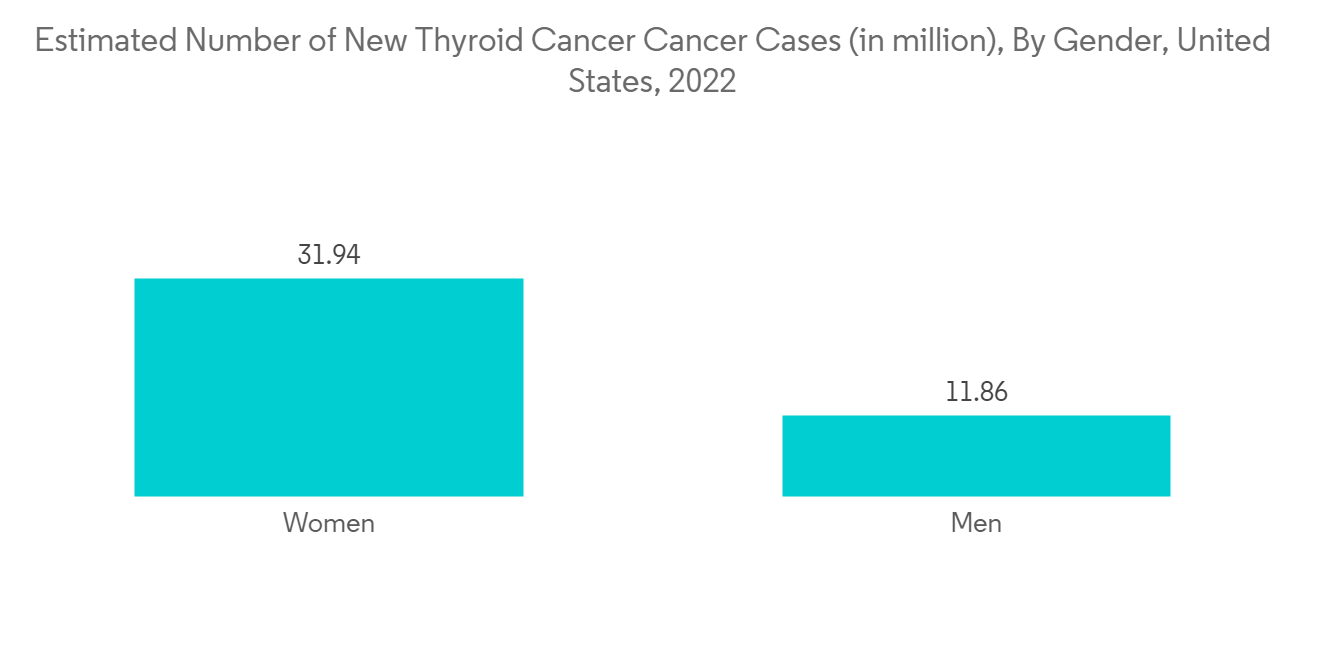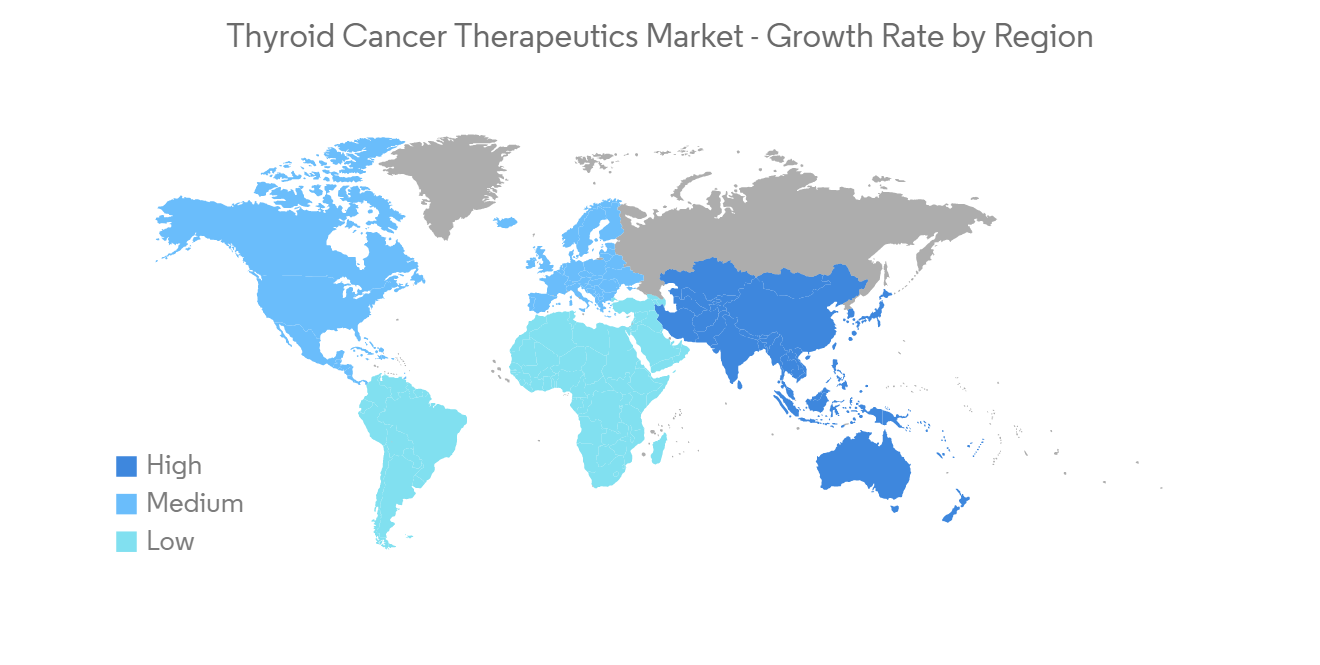 |
市場調査レポート
商品コード
1244367
甲状腺がん治療薬の世界市場- 成長、動向、予測(2023年-2028年)Thyroid Cancer Therapeutics Market - Growth, Trends, and Forecasts (2023 - 2028) |
||||||
● お客様のご希望に応じて、既存データの加工や未掲載情報(例:国別セグメント)の追加などの対応が可能です。 詳細はお問い合わせください。
| 甲状腺がん治療薬の世界市場- 成長、動向、予測(2023年-2028年) |
|
出版日: 2023年03月03日
発行: Mordor Intelligence
ページ情報: 英文 115 Pages
納期: 2~3営業日
|
- 全表示
- 概要
- 目次
世界における甲状腺がん治療薬市場は、予測期間中に12.4%のCAGRで推移すると予想されています。
COVID-19の突然の発症は、初期段階での研究市場に大きな影響を与えました。がん患者が免疫不全であったため、がん患者の治療が中止されました。このため、甲状腺がん患者に対する放射線治療や手術の需要が阻害されました。しかし、パンデミックの後期には、甲状腺がん患者におけるCOVID-19感染の重症度を明らかにするための調査・研究が増加しました。2022年9月にCancers Journalに掲載された論文によると、韓国の大学病院で甲状腺手術を受けた患者の3年間(2019年、2020年、2021年)のデータを収集したところ、甲状腺乳頭がん(PTC)の患者では、甲状腺外進展、リンパ管侵襲、血管侵襲、頸部リンパ節転移の割合が増加していることが確認されました。このような調査から、パンデミック時に甲状腺がん患者のリスクが増加し、甲状腺がんに対する様々な治療オプションに対する需要が生まれ、市場に大きな影響を与えました。また、世界の規制が緩和され、検診が再開されたことで、現在の市場規模は安定しつつあります。
甲状腺がんの有病率や発症率の増加、甲状腺がんの治療法に関する意識の高まり、政府資金の増加や有利な償還政策などの要因は、市場の成長を促進すると予想される主要因です。
甲状腺がんは、甲状腺に発症し、体の他の部位に転移する可能性のあるがんの一種です。甲状腺は内分泌系の一部であり、体内のホルモンを生産・制御しています。2022年3月に更新されたIARCのデータによると、甲状腺がんの罹患率には大きな地理的変動があります。IARCの通り、高所得国では高い発症率が認められ、甲状腺がんの発症率は男性よりも女性の方が高く、男性の3倍となっています。
また、2022年11月にNCBIに掲載された論文によると、甲状腺乳頭がんは甲状腺がんの中で最も多く、甲状腺がん全体の約80-85%を占めています。甲状腺がんが大きくなると、首の皮膚から感じるしこり(結節)、飲み込みにくさ、首や喉の痛み、首のリンパ節の腫れなどが起こり、場合によっては死に至ることもあります。そのため、病気の蔓延を抑え、病気への負担を防ぐために、治療薬の需要が高まっています。これが市場成長の原動力となっており、分析期間中も市場の成長は続くと予想されます。
さらに、世界の甲状腺がんの症例の増加、政府資金の増加、甲状腺がん治療の選択肢に関する意識の高まりが、甲状腺がん治療薬市場の主要な促進要因となっています。例えば、2021年10月、英国のNational Institute for Health and Care Excellence(NICE)は、一種の進行甲状腺がんを持つ一部の人の治療にEli Lillyのセルパーカチニブを推奨し、この薬はCancer Drugs Fundを通じて入手できます。この基金は、RET(rearranged during transfection)遺伝子に変異を持つ進行性甲状腺がん患者の選択肢として、新しい可能性のある薬剤へのアクセスを提供することを支援するものです。このように、甲状腺がんのより良い治療のために、このような先進的な治療薬が利用でき、推奨されていることは、予測期間中の市場成長に貢献すると予想されます。
しかし、ブランド薬の特許切れや様々なジェネリック医薬品の革新は、分析期間中の市場の成長を抑制すると予想されます。
甲状腺がん治療薬市場の動向
医薬品分野が主要な市場シェアを占め、市場推計・予測期間中も同様と予測
甲状腺がん治療薬市場では、医薬品分野が大きなシェアを占めており、予測期間中も同様の傾向を示すと予想されています。甲状腺がん治療薬は、より効果的でがんの進行を防ぐことができるため、併用薬の使用が増加しており、その需要は増加しています。そのため、この分野の成長を牽引しています。
放射性治療、手術、その他の治療が効かない場合、分化型甲状腺がんや髄様甲状腺がんの患者は標的薬剤で治療されます。2021年5月にCancer Research UKが更新したデータによると、甲状腺がんの標的抗がん剤の多くは、経口投与に利用できる錠剤またはカプセルです。また、上記出典の通り、標的型抗がん剤は、がん細胞の違いを狙って作用し、がんの縮小や増殖抑制、症状の軽減に役立ちます。標的薬は、甲状腺乳頭がん、濾胞がん、ヒュルトレ細胞がん、甲状腺髄質がんなどの分化型甲状腺がんに多く使用されます。このような臨床的意義から、これらの薬剤は需要が高まり、市場の成長を加速させています。
また、現在、市場関係者は化学療法薬や標的治療薬の開発に力を入れており、これがこのセグメントの成長をさらに後押ししています。例えば、2022年3月、欧州医薬品庁(EMA)のヒト用医薬品委員会(CHMP)は、Ipsenが開発したCabometyxを、事前の全身療法中または後に進行した放射性ヨード不応または不適格の局所進行または転移性分化型甲状腺がん(DTC)成人患者の治療のための単独療法として承認を勧告しました。このような製品承認により、当分野は分析期間中に大きな成長を遂げると予測されています。

北米が市場で大きなシェアを占めると予想され、予測期間中も同様であると予想されます。
北米は、予測期間中、甲状腺がん治療薬市場で大きな市場シェアを占めると予想されます。同地域の対象人口における甲状腺がんの負担が大きいこと、国ごとに市場参入企業が集中していること、新製品が継続的に承認されていることから、同地域で市場の成長が見込まれています。
中でも米国は、甲状腺がん患者の増加や同国での製品承認により、市場の主要なシェアを占めると予想されます。2021年3月に更新されたCDCのデータによると、毎年、同国では約33,000人の女性と12,000人の男性が甲状腺がんに罹患しています。また、2022年1月に米国がん協会(ACS)が更新したデータによると、2022年末までに新たに43,800人近くの甲状腺がん患者が発生すると予測され、そのうち米国では男性11,860人、女性31,940人と推定されています。したがって、これらの数字は、治療のために革新的で高度な治療オプションを必要とする対象者の間で、甲状腺がんの負担があることを示しています。それゆえ、同国での市場成長を牽引しています。
さらに、確立されたヘルスケアインフラの存在や、新しい治療法の開発に携わる製薬会社やバイオテクノロジー大手企業の存在も、この地域における市場全体の成長をより大きく後押ししています。例えば、2021年9月、Exelixis, Inc.が開発したカボザンチニブ(Cabometyx)は、VEGFRを標的とした先行治療後に進行した局所進行または転移性分化型甲状腺がん(DTC)で、放射性ヨードに対して不適格または不応の成人および12歳以上の小児患者に対してFDAから承認されました。
また、2021年6月、カナダ保健省はRetevmo(セルパーカチニブ)の条件付適合通知(NOC/c)を発行しました。Retevmoは、RET(rearranged during transfection)駆動の進行した肺がんおよび甲状腺がんの患者に特化した治療として、単剤療法を適応としています。このように、同地域でのこのような承認は、研究対象市場の成長を加速させています。したがって、予測期間中、北米は甲状腺がん治療薬市場で大きなシェアを占めると予想されます。

甲状腺がん治療薬産業の概要
甲状腺がん治療薬市場は断片的です。調査された市場は競争的であり、複数の主要企業で構成されています。市場シェアの面では、現在、少数の主要プレイヤーが市場を独占しています。現在市場を独占している企業には、Sanofi(Genzyme Corporation)、Exelixis, Inc、Medtronic Plc、Eisai、Bayer AG、AbbVie Inc、Novartis AG、Pfizer Inc、Mylan N.V.およびBristol-Myers Squibb Companyなどがあります。
その他の特典:
- エクセル形式の市場予測(ME)シート
- 3ヶ月のアナリストサポート
目次
第1章 イントロダクション
- 調査の前提条件と市場の定義
- 調査対象範囲
第2章 調査手法
第3章 エグゼクティブサマリー
第4章 市場力学
- 市場概要
- 市場促進要因
- 甲状腺がんの有病率・罹患率の増加について
- 甲状腺がんの治療法に関する意識の高まり
- 上昇する政府系ファンドと有利な償還政策
- 市場抑制要因
- 先発医薬品の特許切れによる後発医薬品のイントロダクションついて
- ポーターファイブフォース
- 新規参入業者の脅威
- 買い手/消費者の交渉力
- 供給企業の交渉力
- 代替品の脅威
- 競争企業間の敵対関係の強さ
第5章 市場セグメンテーション(金額)
- タイプ別
- 甲状腺乳頭がん
- 濾胞性甲状腺がん
- 甲状腺髄質がん(MTC)
- 甲状腺未分化がん
- ヒュルトル細胞がん
- セラピーによる
- 薬物
- 放射線治療
- その他の治療法
- 地域
- 北米
- 米国
- カナダ
- メキシコ
- 欧州
- ドイツ
- 英国
- フランス
- イタリア
- スペイン
- その他欧州
- アジア太平洋地域
- 中国
- 日本
- インド
- オーストラリア
- 韓国
- その他アジア太平洋地域
- 中東・アフリカ地域
- GCC
- 南アフリカ
- その他中東・アフリカ地域
- 南米
- ブラジル
- アルゼンチン
- その他南米地域
- 北米
第6章 競合情勢
- 企業プロファイル
- Sanofi(Genzyme Corporation)
- Exelixis, Inc
- F. Hoffmann-La Roche Ltd(Genentech, Inc.)
- Eisai Co., Ltd
- Bayer AG
- AbbVie Inc
- Novartis AG
- Pfizer Inc
- Viatris Inc.(Mylan N.V.)
- Bristol-Myers Squibb Company
- Eli Lilly and Company
第7章 市場機会と今後の動向
The thyroid cancer therapeutics market is expected to register a CAGR of 12.4% during the forecast period.
The sudden onset of COVID-19 significantly impacted to studied market during the initial phases. Due to the cancer patients being immunodeficient, the treatment for carcinoma patients was halted. This hampered the demand for radiotherapy treatments and surgeries for thyroid cancer patients. However, during the later phases of the pandemic, the research and studies increased to determine the severity of COVID-19 infection among thyroid cancer patients. As per an article published in the Cancers Journal in September 2022, when three years of data (2019, 2020, and 2021) on patients who received thyroid surgery in a university hospital in South Korea was collected, in patients with papillary thyroid carcinoma (PTC) increased proportions of extrathyroidal extension, lymphatic invasion, vascular invasion, and cervical lymph node metastasis was observed. Thus, such research showed an increased risk among thyroid cancer patients during the pandemic and created a demand for various treatment options available for thyroid cancer, considerably impacting the market. In addition, the market growth is stabilizing in the current scenario as the worldwide restrictions have eased down and disease screening services have been resumed.
Factors such as increasing prevalence and incidence rates of thyroid cancer, growing awareness about treatment options for thyroid cancer, and rising government funds and favorable reimbursement policies are major contributors that are expected to drive market growth.
Thyroid cancer is a type of cancer that develops in the thyroid gland and can spread to other parts of the body. The thyroid gland is a part of the endocrine system that produces and controls the hormones in the body. As per IARC data updated in March 2022, there is huge geographical variability in thyroid cancer incidence rates. As per IARC, in high-income countries, high incidence rates were observed, and the incidence rate of thyroid cancer was higher in women than men, which was three times higher than men.
In addition, as per an article published in NCBI in November 2022, papillary thyroid cancer is the most common type of thyroid cancer, accounting for about 80 - 85% of all thyroid cancer cases. As thyroid cancer grows, it may cause a lump (nodule) that can be felt through the skin on the neck, difficulties in swallowing, pain in the neck and throat, and swollen lymph nodes in the neck, and it can be deadly in some cases. Thus, to control the spread of the disease and prevent the disease burden, therapeutics demand is increasing. This is driving the market growth, and the market is expected to continue to grow over the analysis period.
Furthermore, rising cases of thyroid cancer worldwide, increasing government funds, and growing awareness regarding thyroid cancer treatment options are the key driving factors in the thyroid cancer therapeutics market. For instance, in October 2021, the National Institute for Health and Care Excellence (NICE), United Kingdom, recommended Eli Lilly's selpercatinib to treat some individuals with a kind of advanced thyroid cancer, and the drug is available through the Cancer Drugs Fund. This fund aids in offering access to new potential drugs as an option for individuals with advanced thyroid cancer who harbor alterations in the rearranged during transfection (RET) gene. Thus, the availability of and recommendation for such advanced therapeutics for the better treatment of thyroid cancers is anticipated to contribute to the market growth over the forecast period.
However, the patent expiry of the branded drugs and innovation of various generics drugs is anticipated to restrain the growth of the market studied during the analysis period.
Thyroid Cancer Therapeutics Market Trends
Drugs Segment Held a Major Market Share and is Estimated to do the Same Over the Forecast Period
The drugs segment holds a significant market share in the thyroid cancer therapeutics market and is anticipated to show a similar trend over the forecast period. Owing to an increase in the use of combination drugs, as these are more effective and help to prevent cancer progression, the demand for the drugs is increasing. Thereby driving the segment growth.
When radioactive therapies, surgery, and other treatments do not work, patients are treated with targeted drugs for differentiated or medullary thyroid cancer. As per the data updated by Cancer Research UK in May 2021, most of the targeted cancer drugs for thyroid cancer are tablets or capsules available for oral administration. In addition, as per the source above, targeted drugs work by targeting the differences in cancer cells and help to shrink or control the growth of cancer and to reduce symptoms. The Targeted drugs are most often used for differentiated thyroid cancer, such as papillary, follicular, or Hurthle cell thyroid cancer, or medullary thyroid cancer. Due to the clinical significance of the drugs, these are gaining demand, accelerating market growth.
In addition, currently, market players are focusing more on chemotherapy drugs or targeted therapy development, which are further fueling the segment's growth. For instance, in March 2022, the Committee for Medicinal Products for Human Use (CHMP) of the European Medicines Agency (EMA) recommended approval of Cabometyx, developed by Ipsen, as a monotherapy for the treatment of adult patients with locally advanced or metastatic differentiated thyroid carcinoma (DTC), refractory or not eligible to radioactive iodine which has progressed during or after prior systemic therapy. Thus, owing to such product approvals, the segment is anticipated to witness significant growth during the analysis period.

North America is Expected to Hold a Significant Share in the Market and Expected to do Same in the Forecast Period
North America is expected to hold a significant market share in the thyroid cancer therapeutics market over the forecast period. Due to the high burden of thyroid cancer among the target population in the region, a high concentration of market players across the countries, and continuous approval for new products, the market is anticipated to witness growth in the region.
The United States, among other countries, is expected to hold a major share of the market due to increasing cases of thyroid cancer and product approval in the country. According to the CDC data updated in March 2021, every year, about 33,000 women and 12,000 men suffer from thyroid cancer in the country. In addition, as per the data updated by the American Cancer Society (ACS) in January 2022, nearly 43,800 new cases of thyroid cancer were predicted to be diagnosed by the end of 2022, among which 11,860 cases were estimated to be in men and 31,940 in women in the United States. Thus, these numbers show that there is a burden of thyroid cancer among the target population that requires innovative and advanced treatment options for treatment. Hence, driving the market growth in the country.
Furthermore, the presence of a well-established healthcare infrastructure and the presence of pharma and biotech major companies involved in the development of new therapies is also fueling the growth of the overall market to a larger extent in the region. For instance, in September 2021, cabozantinib (Cabometyx) developed by Exelixis, Inc., for adult and pediatric patients 12 years of age and older with locally advanced or metastatic differentiated thyroid cancer (DTC) that has progressed following prior VEGFR-targeted therapy and who are ineligible or refractory to radioactive iodine was approved by FDA.
In addition, in June 2021, Health Canada issued a Notice of Compliance with conditions (NOC/c) for Retevmo (selpercatinib). Retevmo is indicated as monotherapy for the treatment specifically of patients with advanced rearranged during transfection (RET)-driven lung and thyroid cancers. Thus, such approvals in the region are accelerating the growth of the studied market. Therefore, North America is expected to occupy a significant share of the thyroid cancer therapeutics market over the forecast period.

Thyroid Cancer Therapeutics Industry Overview
The thyroid cancer therapeutics market is fragmented. The studied market is competitive and consists of several major players. In terms of market share, a few of the major players are currently dominating the market. Some of the companies which are currently dominating the market include Sanofi (Genzyme Corporation), Exelixis, Inc, Medtronic Plc, Eisai Co., Ltd, Bayer AG, AbbVie Inc, Novartis AG, Pfizer Inc, Mylan N.V. and Bristol-Myers Squibb Company, among others.
Additional Benefits:
- The market estimate (ME) sheet in Excel format
- 3 months of analyst support
TABLE OF CONTENTS
1 INTRODUCTION
- 1.1 Study Assumptions and Market Definition
- 1.2 Scope of the Study
2 RESEARCH METHODOLOGY
3 EXECUTIVE SUMMARY
4 MARKET DYNAMICS
- 4.1 Market Overview
- 4.2 Market Drivers
- 4.2.1 Increasing Prevalence and Incidence Rates of Thyroid Cancer
- 4.2.2 Growing Awareness about Treatment Options for Thyroid Cancer
- 4.2.3 Rising Government Funds and Favorable Reimbursement Policies
- 4.3 Market Restraints
- 4.3.1 Patent Expiry of the Branded Drugs Leading to Introduction of Generic Drugs
- 4.4 Porter Five Forces
- 4.4.1 Threat of New Entrants
- 4.4.2 Bargaining Power of Buyers/Consumers
- 4.4.3 Bargaining Power of Suppliers
- 4.4.4 Threat of Substitute Products
- 4.4.5 Intensity of Competitive Rivalry
5 MARKET SEGMENTATION (Market Size by Value - USD million)
- 5.1 By Type
- 5.1.1 Papillary thyroid cancer
- 5.1.2 Follicular thyroid cancer
- 5.1.3 Medullary thyroid cancer (MTC)
- 5.1.4 Anaplastic thyroid cancer
- 5.1.5 Hurthle cell cancer
- 5.2 By Therapy
- 5.2.1 Drugs
- 5.2.2 Radiation Therapy
- 5.2.3 Other Therapies
- 5.3 Geography
- 5.3.1 North America
- 5.3.1.1 United States
- 5.3.1.2 Canada
- 5.3.1.3 Mexico
- 5.3.2 Europe
- 5.3.2.1 Germany
- 5.3.2.2 United Kingdom
- 5.3.2.3 France
- 5.3.2.4 Italy
- 5.3.2.5 Spain
- 5.3.2.6 Rest of Europe
- 5.3.3 Asia-Pacific
- 5.3.3.1 China
- 5.3.3.2 Japan
- 5.3.3.3 India
- 5.3.3.4 Australia
- 5.3.3.5 South Korea
- 5.3.3.6 Rest of Asia-Pacific
- 5.3.4 Middle East and Africa
- 5.3.4.1 GCC
- 5.3.4.2 South Africa
- 5.3.4.3 Rest of Middle East and Africa
- 5.3.5 South America
- 5.3.5.1 Brazil
- 5.3.5.2 Argentina
- 5.3.5.3 Rest of South America
- 5.3.1 North America
6 COMPETITIVE LANDSCAPE
- 6.1 Company Profiles
- 6.1.1 Sanofi (Genzyme Corporation)
- 6.1.2 Exelixis, Inc
- 6.1.3 F. Hoffmann-La Roche Ltd (Genentech, Inc.)
- 6.1.4 Eisai Co., Ltd
- 6.1.5 Bayer AG
- 6.1.6 AbbVie Inc
- 6.1.7 Novartis AG
- 6.1.8 Pfizer Inc
- 6.1.9 Viatris Inc. (Mylan N.V.)
- 6.1.10 Bristol-Myers Squibb Company
- 6.1.11 Eli Lilly and Company
